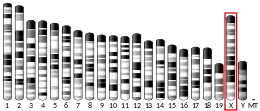| MAGEA10 | |||||||||||||||||||||||||||||||||||||||||||||||||||
|---|---|---|---|---|---|---|---|---|---|---|---|---|---|---|---|---|---|---|---|---|---|---|---|---|---|---|---|---|---|---|---|---|---|---|---|---|---|---|---|---|---|---|---|---|---|---|---|---|---|---|---|
| Identifiers | |||||||||||||||||||||||||||||||||||||||||||||||||||
| Aliases | MAGEA10, CT1.10, MAGE10, MAGE family member A10 | ||||||||||||||||||||||||||||||||||||||||||||||||||
| External IDs | OMIM: 300343 MGI: 3588211 HomoloGene: 121621 GeneCards: MAGEA10 | ||||||||||||||||||||||||||||||||||||||||||||||||||
| |||||||||||||||||||||||||||||||||||||||||||||||||||
| |||||||||||||||||||||||||||||||||||||||||||||||||||
| |||||||||||||||||||||||||||||||||||||||||||||||||||
| |||||||||||||||||||||||||||||||||||||||||||||||||||
| Wikidata | |||||||||||||||||||||||||||||||||||||||||||||||||||
| |||||||||||||||||||||||||||||||||||||||||||||||||||
MAGEA10 (MAGE family member A10) is a protein-coding gene in humans clustered at chromosomal location Xq28. [5]
Function
This gene is a member of the MAGEA gene family. The members of this family encode proteins with 50 to 80% sequence identity to each other. The promoters and first exons of the MAGEA genes show considerable variability, suggesting that the existence of this gene family enables the same function to be expressed under different transcriptional controls.
The MAGEA genes are clustered at chromosomal location Xq28. They have been implicated in some hereditary disorders, such as dyskeratosis congenita. Alternative splicing results in multiple transcript variants. Read-through transcription also exists between this gene and the downstream melanoma antigen family A, 5 (MAGEA5) gene.
References
- 1 2 3 GRCh38: Ensembl release 89: ENSG00000124260 - Ensembl, May 2017
- 1 2 3 GRCm38: Ensembl release 89: ENSMUSG00000043453 - Ensembl, May 2017
- ↑ "Human PubMed Reference:". National Center for Biotechnology Information, U.S. National Library of Medicine.
- ↑ "Mouse PubMed Reference:". National Center for Biotechnology Information, U.S. National Library of Medicine.
- ↑ "Entrez Gene: MAGE family member A10". Retrieved 2017-06-15.
Further reading
- Lin J, Lin L, Thomas DG, Greenson JK, Giordano TJ, Robinson GS, Barve RA, Weishaar FA, Taylor JM, Orringer MB, Beer DG (2004). "Melanoma-associated antigens in esophageal adenocarcinoma: identification of novel MAGE-A10 splice variants". Clin. Cancer Res. 10 (17): 5708–16. doi:10.1158/1078-0432.CCR-04-0468. PMID 15355897.
- Schultz-Thater E, Piscuoglio S, Iezzi G, Le Magnen C, Zajac P, Carafa V, Terracciano L, Tornillo L, Spagnoli GC (2011). "MAGE-A10 is a nuclear protein frequently expressed in high percentages of tumor cells in lung, skin and urothelial malignancies". Int. J. Cancer. 129 (5): 1137–48. doi:10.1002/ijc.25777. PMID 21710496.
- Badovinac Črnjević T, Tanja BČ, Spagnoli G, Giulio S, Juretić A, Antonio J, Jakić-Razumović J, Jasminka JR, Podolski P, Paula P, Šarić N, Nera Š (2012). "High expression of MAGE-A10 cancer-testis antigen in triple-negative breast cancer". Med. Oncol. 29 (3): 1586–91. doi:10.1007/s12032-011-0120-9. PMID 22116775. S2CID 22748757.
- Wang L, Xu Y, Luo C, Sun J, Zhang J, Lee MW, Bai A, Chen G, Frenz CM, Li Z, Huang W (2015). "MAGEA10 gene expression in non-small cell lung cancer and A549 cells, and the affinity of epitopes with the complex of HLA-A(∗)0201 alleles". Cell. Immunol. 297 (1): 10–8. doi:10.1016/j.cellimm.2015.05.004. PMID 26058806.
This article incorporates text from the United States National Library of Medicine, which is in the public domain.



